
Courtland is an incorporated town in Southampton County, Virginia, United States. It is the county seat of Southampton County.

Accomac Historic District is a national historic district located at Accomac, Accomack County, Virginia. The district encompasses 158 contributing buildings in the town of Accomac, mainly grouped into two periods of construction. From its founding in 1786 through the second quarter of the nineteenth century, several residential, commercial, governmental, and religious structures were built in the core of Accomac, representing both high-style and vernacular examples of late Georgian, Federal, and Greek Revival styles. Notable structures surviving from this period include the rectory of St. George's Episcopal Parish ; the Seymour House (1791-1815); Roseland (1750-1850); Seven Gables (1786-1905); Rural Hill, and the Francis Makemie Presbyterian Church (1840). The second period of construction reflected in the town dates to the last quarter of the nineteenth century, when the arrival of the New York, Philadelphia, and Norfolk Railroad spawned renewed growth and economic prosperity in Accomack County following the Civil War. These buildings also display both high-style and vernacular expressions of Victorian Era styles, including Second Empire, Italianate, Gothic Revival, and Romanesque. Notable structures from this time period include Bayly Memorial Hall, the County Clerk's Office (1887), the Accomack County Courthouse (1899), and houses found in the Lilliston Avenue extension of the town built in the 1880s-1890s. There are also contributing structures dating from the first quarter of the twentieth century, including the Drummondtown Baptist Church (1914), Drummondtown United Methodist Church (1920), and the former hotel at the town square (1925).

Brunswick County Courthouse Square is a historic county courthouse complex and national historic district located at Lawrenceville, Brunswick County, Virginia. It encompasses four contributing buildings and two contributing objects. They are the courthouse building, a clerk's office, library, jail, Confederate war monument, and a simple granite slab monument commemorating the county's veterans of World War I to the Vietnam War. Together they constitute a classic Southern courthouse square. The courthouse was built in 1854–55, as a two-story, gable-roofed rectangular brick building in the Greek Revival style. In 1939, a rear brick addition was completed, creating a T-shaped plan. The clerk's office is a two-story brick building built in 1893, with rear additions built in 1924 and 1939. The library was built in 1941.

The Old Clarke County Courthouse is a historic county courthouse complex located at Berryville, Clarke County, Virginia. The complex includes the Old Clarke County Courthouse, built in 1837; the original county clerk's building, dating from the 1880s; and a two-story building built about 1900 and containing the Sheriff's office and county jail. The former courthouse is a two-story, red brick temple-form structure, fronted by a full-height Tuscan order portico in the Roman Revival style. The building served as the county's courthouse until 1977, when a new courthouse was erected. It was subsequently designated the General District Courts Building.

Town of Halifax Court House Historic District is a national historic district located at Halifax, Halifax County, Virginia. The district includes 172 contributing buildings, 1 contributing site, 13 contributing structures, and 1 contributing object in the Town of Halifax. Resources include government, commercial, residential, religious, educational and industrial buildings that date from the early-19th Century to the mid-20th century. Notable buildings include the Rice House, Edmunds/Lewis Office (1869), People's Bank, Beth Car Baptist Church (1892), Christ Episcopal Church, Saint Luke's Christian Methodist Episcopal Church, Dr. Carter House, County Office Building (1915), Town of Halifax Swimming Pool (1930s), Municipal Building/ Fire Station (1950), Halifax Roller Mills (1915), Halifax Planing Mill, Halifax Department Store (1949), and Randolph Theater. Also located in the district is the separately listed Halifax County Courthouse.

Eastville Historic District is a national historic district located at Eastville, Northampton County, Virginia. The district encompasses 315 contributing buildings, 7 contributing sites, and 4 contributing structures in the county seat of Northampton County. The historic district contains a wide variety of residential, commercial, governmental, educational, social, religious, and funerary resources dating from 1731. Notable buildings include the courthouse (1731), clerk's office, Park Hall, Eastville Inn, Ingleside, Hickory Grounds, Maria Robins House, the Old Brick Store, Abdell Funeral Home, Edward Holland House, and Ailworth Hall. Also located in the district are the separately listed Cessford, Eastville Mercantile, and James Brown's Dry Goods Store.

Heathsville Historic District is a national historic district located at Heathsville, Northumberland County, Virginia. The district includes 81 contributing buildings, 12 contributing sites, 4 contributing structures, and 4 contributing objects in the county seat of Northumberland County. It is an assemblage of residential, commercial, and government buildings dating from the 18th through 20th centuries in a variety of popular architectural styles. The linear district is centered on the courthouse square. Notable buildings include the Northumberland Court House, the old county jail (1844), the former Methodist Protestant Church, Harding House, Belleville, Heathsville Masonic Lodge No. 109 (1894), Bank of Northumberland (1924), and the Heathsville United Methodist Church (1894). Located in the district and separately listed are Rice's Hotel, Oakley, St. Stephen's Church, Sunnyside, and The Academy.

Luray Downtown Historic District is a national historic district located at Luray, Page County, Virginia. The district includes 75 contributing buildings, 1 contributing structure, and 3 contributing objects in the central business district of the town of Luray. They include residential, commercial, governmental, and institutional buildings in a variety of popular 19th and 20th century architectural styles. Notable buildings include the Skyline Building, Luray Motor Company (1935), Luray United Methodist Church (1899-1900), Luray Post Office (1938), Page County Record Building (1912), Bridge Theatre, Casey Jones Overall Factory (1922), Mansion Inn, Jordan-McKim Building, Hotel Laurance, and Mimslyn Inn (1930-1931). The contributing objects include the Confederate Monument (1918) and clock. Located in the district are the separately listed Luray Norfolk and Western Passenger Station and Page County Courthouse.

Powhatan Courthouse Historic District is a county courthouse complex and national historic district located at Powhatan, Powhatan County, Virginia. The district includes four contributing buildings. The Powhatan County Court House was built in 1848–1849, and is a stuccoed temple-form Greek Revival style building measuring approximately 40 feet by 54 feet. There is strong circumstantial evidence that it is the work of Alexander Jackson Davis. Associated with the courthouse are the contributing former clerk's office, a T-shaped brick structure dated to the late 18th century; the early 19th-century former jail; and Scott's or Powhatan Tavern, a large late 18th-century tavern, a 2+1⁄2-story, brick structure.
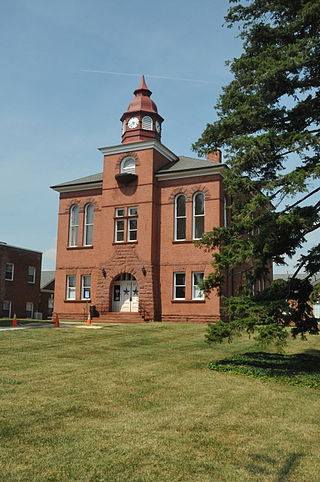
Prince William County Courthouse is a historic courthouse located at 9248 Lee Avenue, Manassas, Prince William County, Virginia. Rehabilitated in 2000–2001, it currently houses some offices of the Prince William County clerk, and the historic courtroom upstairs can be rented for events.
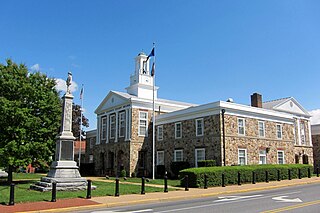
Warren County Courthouse is a historic county courthouse complex located at Front Royal, Warren County, Virginia. It was built in 1935–1936, and is a two-story, stone faced concrete block, Colonial Revival style building. It consists of a central rectangular block with a pedimented gable roof and smaller flanking recessed wings. The central block is topped by a three-stage cupola with an open and domed belfry. Also on the property are the contributing brick clerk's office, brick jail, and two war memorials - a Confederate Monument, dedicated in 1911, and an obelisk honoring veterans of World Wars I and II.
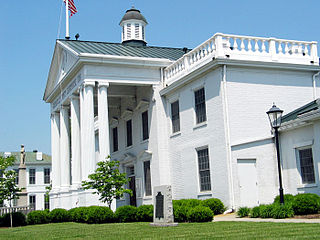
Greensville County Courthouse Complex is a historic courthouse complex located at South Main Street between Hicksford Avenue and Spring Street in Emporia, Virginia. The three contributing buildings are the two-story, porticoed courthouse built in 1834, the clerk's office built in 1894, and the former Greensville Bank Building, now the county administrator's office, in 1900 and 1907. The courthouse originally took a Palladian form, but was remodeled between 1907 and 1910 to take a Beaux-Arts appearance. The clerk's office was considerably enlarged in 1916 and the Georgian-style facade added in 1961. The interior of the county administrator's office features elaborate pressed-tin walls and ceilings manufactured by the local concern, H.T. Klugel. The buildings are set upon the courthouse square, which includes a cannon honoring residents who participated in World War I, and a Confederate monument.

Suffolk Historic District is a national historic district located at Suffolk, Virginia. The district encompasses 514 contributing buildings, 3 contributing structures, and 3 contributing objects in Suffolk. The district includes a variety of residential, commercial, governmental, and institutional buildings. They are in a variety of vernacular and popular 19th and 20th century architectural styles including Greek Revival, Queen Anne, and Bungalow. Notable buildings include the Allmond Building (1914), Macedonia A.M.E. Church, National Bank of Suffolk (1914-1920), the Old Post Office, old Nansemond County Courthouse, John Granberry house, Richard Seth Eley House (1878), Jones Building, Suffolk Towers, Virginia Apartments (1918-1920), Causey-Kendrick house (1882), Masonic Hall (1911), Suffolk High School (1922), Jefferson High School (1911), old Methodist Church (1861), St. Paul's Episcopal Church (1895), Suffolk Christian Church (1893), and Congregation of Agudath Achin. Located in the district are the separately listed Phoenix Bank of Nansemond, Professional Building, and Riddick House.

The Winchester Historic District is a national historic district located at Winchester, Virginia. The district encompasses 1,116 contributing buildings in Winchester. The buildings represent a variety of popular architectural styles including Late Victorian and Italianate. They include residential, commercial, governmental, industrial, and institutional buildings dating from the 18th to mid-20th centuries. Notable buildings include the A.M.E Church (1878), Masonic Lodge and Gray and Eddy Building, First Presbyterian Church, Farmers and Merchants Bank (1902), Frederick County Courthouse (1840), Grace Lutheran Church, Friendship Fire Hall (1892), John Kerr School, City Hall (1900), Lewis Jones Knitting Mill (1895), Tidball Residence, William F. Hottle Residence, McGuire Residence, and Robert Long House. Located in the district are the separately listed Thomas J. Jackson Headquarters, Fair Mount, Handley Library, Adam Kurtz House, and Daniel Morgan House.
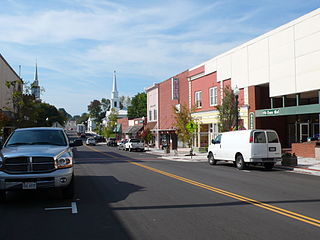
Christiansburg Downtown Historic District is a national historic district located at Christiansburg, Montgomery County, Virginia. The district encompasses 32 contributing buildings, 1 contributing site, and 2 contributing objects in the central business district of Christiansburg. The district includes a variety of one-, two-, or three-story commercial or office buildings built primarily from the 1915-1950 period. The courthouse square is the cultural and historic center of the district. Notable buildings include the Taylor Office Building, Bank of Christiansburg (1963), Dr. George Anderson House, Zirkle Building (1910), Cromer Furniture Building, Presbyterian Manse (1876), Barnes-Surface Motor Co., Virginia Inn Hotel, and Leggett's Department Store (1958). The contributing objects are the Confederate Memorial (1883) and War Memorial (1953). Located in the district and separately listed are Christiansburg Presbyterian Church, U.S. Post Office, and Phlegar Building.

Henderson Central Business Historic District is a national historic district located at Henderson, Vance County, North Carolina. It encompasses 91 contributing buildings and 1 contributing structure in the central business district of Henderson. The district developed between about 1881 and 1937 and includes notable examples of Romanesque Revival and Classical Revival architecture styles. Located in the district are the separately listed Henderson Fire Station and Municipal Building, Vance County Courthouse, and Zollicoffer's Law Office. Other notable buildings include the (former) First National Bank (1921), Davis Department Store, P. H. Rose Building, Gaston Railroad Depot, Pogue's Tobacco Works, J, A. Kelly Tobacco Prizehouse, (former) H. Leslie Perry Public Library, (former) United States Post Office (1911) designed by the Office of the Supervising Architect under James Knox Taylor, O'Neil Building, First United Methodist Church (1930), Holy Innocents Episcopal Church, and First Presbyterian Church.

Marion Downtown Commercial Historic District is a national historic district located at Marion, Grant County, Indiana. It encompasses 52 contributing buildings, 2 contributing structures, and 1 contributing object in the central business district of Marion. It developed between about 1870 and 1942, and includes notable examples of Italianate, Romanesque, and Classical Revival style architecture. Located in the district is the separately listed Grant County Jail and Sheriff's Residence. Other notable buildings are the Grant County Courthouse (1881–1883), Marion Bank Building, Iroquois Building, Dan-Mar Apartments, United Telephone Block, Cecelian Apartments, Marion Post Office, and William Smith Building / Mecca Club.
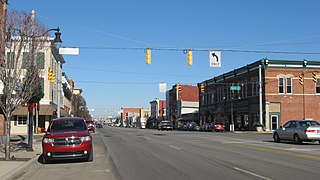
Portland Commercial Historic District is a national historic district located at Portland, Jay County, Indiana. It encompasses 58 contributing buildings, 1 contributing structure, and 1 contributing object in the central business district of Portland. The district developed between about 1870 and 1945, and includes notable examples of Italianate, Romanesque Revival, Classical Revival, and Early Commercial style architecture. Located in the district is the separately listed Jay County Courthouse. Other notable contributing resources include the U.S. Post Office (1914) designed by the Office of the Supervising Architect under Oscar Wenderoth, Portland Fire Station #1 (1929), Citizens Bank, FOE Eagles Lodge (1883), Johnson Building, Stevens Building (1910), Walnut Street Church of Christ (1913), and South Meridian Street Bridge (1914).
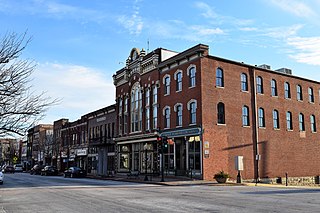
Missouri State Capitol Historic District is a national historic district located at Jefferson City, Cole County, Missouri. It encompasses 122 contributing buildings in the central business district of Jefferson City. The district developed between about 1850 and 1950, and includes representative examples of Classical Revival, Late Victorian, Queen Anne, Mission Revival, and Modern Movement style architecture. Located in the district are the separately listed Missouri State Capitol, Lohman's Landing Building, Cole County Historical Society Building, Cole County Courthouse and Jail-Sheriff's House, Missouri Governor's Mansion, and Tergin Apartment Building. Other notable buildings include the St. Peter's Roman Catholic Church complex (1881-1883), Margaret Upshulte House, Broadway State Office Building (1938), Supreme Court of Missouri (1905-1906), U.S. Post Office and Courthouse (1932-1934), Lohman's Opera House, Missouri State Optical, First United Methodist Church (1900), Carnegie Public Library (1901), Temple Beth El (1883), and Joseph and Susie Kolkmeyer House.
Commercial Community Historic District is a national historic district located at Lexington, Lafayette County, Missouri. The district encompasses 106 contributing buildings and 1 contributing structure in the central business district and surrounding residential area of Lexington. It developed between about 1830 and 1930, and includes representative examples of Late Victorian and Gothic Revival style architecture. Located in the district is the separately listed Lafayette County Courthouse. Other notable buildings include the Lexington Racquetball Club, Missouri Public Service Storage Building, Franklin Diner, Wright House, Goehner's Marbleworks, First Presbyterian Church, Municipal Auditorium (1930), Leiter Apartments, Lafayette County Sheriff's Office and Jail (1939), Morrison Wentworth Bank Building, and Winkler Theatre.
























